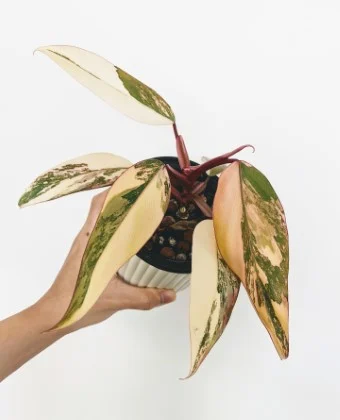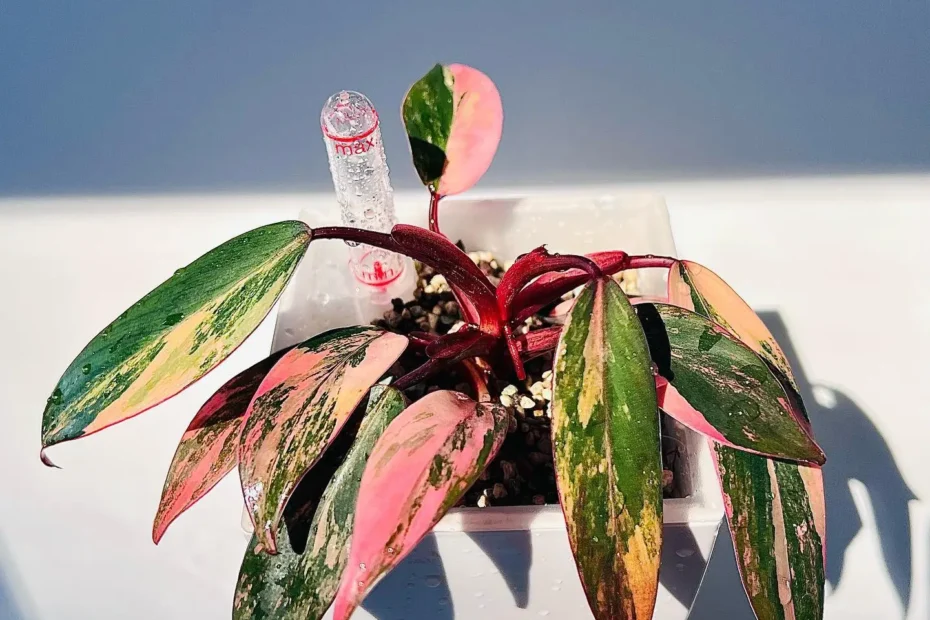Introduction
The first time I laid eyes on the Philodendron Strawberry Shake, it felt as though nature itself had conspired to paint the perfect leaves, blending tones of green, pink, and yellow into a spectacle of vibrant foliage. Each leaf, unique and striking, seemed like a masterpiece. Over the years, my fascination with Philodendrons and houseplants has grown into a nurturing passion, guiding me through the nuances of indoor gardening.
Despite its breathtaking beauty, the Philodendron Strawberry Shake presents its set of challenges, particularly in maintaining the vibrancy of its leaves and ensuring healthy growth. Many enthusiasts find themselves grappling with issues related to lighting, watering, and feeding, often leading to frustration and disappointment. This guide aims to be the beacon for those lost in the care of their precious Strawberry Shake, offering practical, tried-and-tested advice to overcome common pitfalls. With my experience and your enthusiasm, watching your Philodendron flourish will no longer be a matter of luck but a guaranteed joy.
Unveiling the Philodendron Strawberry Shake
Botanical Background
The Philodendron Strawberry Shake, scientifically known as Philodendron Erubescens ‘Strawberry Shake,’ is a captivating plant species that belongs to the Araceae family. Originating from the tropical forests of South America, this plant has adapted to thrive in the warm, humid conditions under the forest canopy, making it a suitable addition to indoor environments. It is celebrated not only for its aesthetic appeal but also for its contribution to purifying the air, making it a valuable companion in homes and offices.
Key Characteristics
One of the most striking features of the Philodendron Strawberry Shake is its variegated leaves, which display a mesmerizing blend of pink, green, and sometimes yellow hues. Each leaf tells a unique story with its pattern, making this plant a standout specimen in any collection. Besides its visual appeal, the Strawberry Shake is a climbing variety, which means that with the right support, it can grow vertically, adding dimension and vibrancy to indoor spaces. Additionally, its air-purifying properties are an added benefit, as it helps remove toxins from the environment, contributing to a healthier living space.
Distinguishing Features
Differentiating the Philodendron Strawberry Shake from similar varieties can be quite straightforward once you know what to look for. The key lies in observing its leaves’ unique coloration pattern – the striking pink variegation is less common among Philodendrons and serves as a distinguishing feature.
Additionally, the size and shape of the leaves, along with the plant’s climbing nature, set it apart from other Philodendron varieties that might have more solid green foliage or a different growth habit. By focusing on these characteristics, enthusiasts can confidently identify and appreciate the unique beauty of the Philodendron Strawberry Shake.
Essential Care Requirements Philodendron Strawberry Shake
Light Requirements
Proper lighting is crucial for the Philodendron Strawberry Shake, as it directly influences the vibrancy of its variegated leaves. The ideal condition is bright, indirect light. Direct sunlight can cause the leaves to fade and even burn, while insufficient light may lead to loss of variegation, making the leaves turn green.
A telltale sign of too much light is bleached or scorched spots on the leaves, whereas inadequate light often results in leggy growth and fewer leaves. Positioning your plant near an east or west-facing window covered with a sheer curtain can provide the perfect balance of light.
Watering Practices
The “dry and wet cycle” is fundamental for the health of your Philodendron Strawberry Shake. Allow the top inch or so of the soil to dry out before watering again. This mimics the natural rainfall pattern the plant would experience in its native habitat, preventing both over and underwatering.
Overwatering can lead to root rot, a common issue among houseplants, so it’s essential to check the soil’s moisture level before watering. Utilizing a pot with drainage holes and a saucer can help manage excess water.
Appropriate Soil Mix
Choosing the right soil mix is vital for the Philodendron Strawberry Shake. A well-draining, aerated potting mix will support its growth by providing proper moisture retention and preventing waterlogging. An ideal mix could include peat moss, perlite, and vermiculite to enhance drainage and aeration.
Some enthusiasts also recommend adding a bit of orchid bark to the mix, which helps mimic the plant’s natural growing conditions by providing additional air space for the roots. These components ensure that the soil remains light and breathable, promoting healthy root development.
Temperature and Humidity Levels
Philodendron Strawberry Shake thrives in temperatures between 65°F (18°C) and 80°F (27°C), which is within the range of most indoor environments. However, it’s vital to keep the plant away from drafts, air conditioners, and heating vents, as sudden temperature fluctuations can stress it. Humidity around 50% is ideal for this tropical plant.
If the air in your home is dry, consider using a humidifier or placing the plant on a pebble tray partially filled with water to increase the surrounding humidity. This will help replicate the moist atmosphere of its natural habitat and support optimal growth.
Optimizing Your Philodendron Strawberry Shake


Fertilization
Fertilizing your Philodendron Strawberry Shake is a key aspect of its care, particularly during the growing seasons of spring and summer. A balanced, diluted fertilizer provides the essential nutrients required for robust growth, vibrant leaf coloration, and overall plant health. It’s advisable to use a 20-20-20 NPK (Nitrogen-Phosphorus-Potassium) water-soluble fertilizer, diluted to half the strength recommended on the package.
Administering this diluted solution once a month during active growth periods supports the development of new foliage and reinforces the plant’s strength. Be cautious to not over-fertilize, as this can lead to nutrient burn, manifesting as browning leaf tips and edges.
Pruning & Training
Pruning and training your Philodendron Strawberry Shake not only maintain its aesthetics but also promote healthier growth. To encourage bushier growth and control any leggy stems, prune back to just above a leaf node; new growth will emerge from this point. Pruning is ideally done in spring or early summer, providing the plant ample time to recover and put out new growth.
To encourage climbing, which is natural behavior for this species, introduce a moss pole into the plant’s pot. Gently tie the plant’s stems to the pole with soft plant ties, guiding its growth upward. This will not only support the plant’s vertical growth but also enhance leaf size, as it mimics the plant’s natural inclination to climb trees in the wild.
Propagation
Propagating Philodendron Strawberry Shake via stem cuttings is a rewarding process to multiply your collection or share with friends. Follow these steps for successful propagation:
- Select a Healthy Stem: Look for a stem with at least two nodes (points where leaves emerge) and a couple of leaves.
- Cut: Using a clean, sharp pair of scissors or a knife, cut just below a node. The ideal length of the cutting is about 4-6 inches.
- Rooting: You can root the cutting in water or directly in soil. For water rooting, place the cutting in a glass of water, ensuring at least one node is submerged. Change the water every few days to keep it fresh. For soil rooting, plant the cutting in a moist, well-draining potting mix, ensuring at least one node is buried in the soil.
- Wait and Watch: Place the cutting in bright, indirect light and wait for roots to develop. This can take a few weeks. If rooted in water, once substantial roots have formed, you can transplant the cutting into soil.
- Transplant: Once your cutting has established a healthy root system, transplant it into a pot with the appropriate soil mix described earlier.
By following these steps, your propagated Philodendron Strawberry Shake will soon start to show new growth, offering the excitement of watching a new plant flourish from a mere cutting.
Philodendron Strawberry Shake Troubleshooting Common Issues
Leaf Discoloration and Stunted Growth
Leaf discoloration and stunted growth in your Philodendron Strawberry Shake can be alarming signs, often indicative of nutrient deficiencies or environmental stress. Yellowing leaves may suggest overwatering or poor drainage, which can be remedied by adjusting watering habits and ensuring your pot has adequate drainage. Conversely, leaves with brown tips or edges might be reacting to low humidity or over-fertilization. Maintaining humidity around 50% and fertilizing responsibly can mitigate these issues.
Pest Infestations
Pest infestations, notably mealybugs and spider mites, can severely impact the health of your plant. These pests suck sap from the leaves, leading to discoloration, wilting, and potentially the death of the plant if left unchecked. Regularly inspect your plant for any signs of infestation, focusing on the undersides of leaves and stems where pests often hide.
Solutions for Pests
In the event of a pest infestation, prompt action is necessary. Insecticidal soap is a gentle yet effective option for controlling mealybugs and spider mites. It works by suffocating the pests without harming the plant. Neem oil, another natural pesticide, disrupts the life cycle of pests, preventing reproduction and further infestation.
It’s important to apply these treatments according to their instructions and in the evening to avoid sunburn on the leaves. Regular application until the pests are completely eradicated is crucial for the health of your Philodendron.
By being attentive to the signs of common issues like leaf discoloration, stunted growth, and pest infestations, and applying appropriate solutions such as insecticidal soap and neem oil, you can ensure your Philodendron Strawberry Shake remains healthy and vibrant.
Conclusion
Caring for a Philodendron Strawberry Shake requires attention to humidity, fertilization, pruning, and proper propagation methods. A balanced, diluted fertilizer during growing seasons, careful pruning for aesthetics and health, and propagation through stem cuttings can significantly benefit the plant. Troubleshooting common issues like leaf discoloration and pest infestations with appropriate solutions helps maintain its vitality.
In conclusion, successful care of your Philodendron encompasses maintaining adequate humidity, regular but careful fertilization, and engaging in pruning and propagation practices. Observing these guidelines will not only ensure robust growth but also enhance the visual appeal of your plant. Should you encounter any challenges or if you have further questions, feel free to ask in the comments section. Our gardening community is here to support you in nurturing your Philodendron Strawberry Shake to its full potential.
